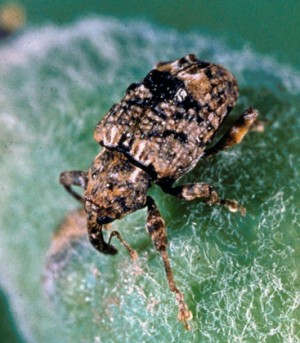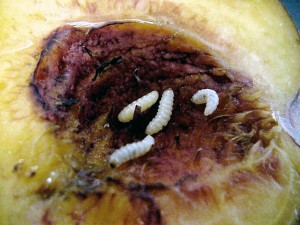Plum Curculio
 Scientific Name
Scientific Name
Conotrachelus nenuphar
Host
This species is primarily a pest of plums and peaches but also damages cherries, nectarines, and apricots. Various species of wild plums are also good hosts. The adults will feed on and damage apples and pears, but few larvae are usually found in these hosts.
Symptoms
The small fruits punctured by the overwintered adults fall to the ground and are lost. Larger fruits punctured by the first generation adults are rendered unmarketable by the feeding of the larvae in the soft tissues and around the pit. The punctures furnish a place for the brown rot fungus to enter. Many infections of brown rot in peaches start in this manner.
Life Cycle
 This insect overwinters as an adult under leaves, grass, bark, sticks, and rubbish
in woodlands or fence rows near orchards and under grass and trash in the orchard.
The adults emerge about the time plums begin blooming, usually in mid-April in Oklahoma.
At first they feed on the blooms and, to some extent, on the unfolding leaves. As
the small fruit begin to develop, they feed on them, leaving small, circular feeding
punctures. The females also cut crescent shaped punctures in the fruit in which to
lay their eggs. Most of the small fruits that are damaged fall to the ground within
a few weeks during May. The larvae develop in the fruits, emerge, and burrow into
the soil. They pupate in small cells two or three inches under the soil surface. First
generation adults begin emerging by mid-June. They feed on and lay eggs in maturing
fruits and the second generation larvae feed in these fruits in July and into August.
Adults developing from these larvae seek overwintering quarters in August and September.
There are two generations per year.
This insect overwinters as an adult under leaves, grass, bark, sticks, and rubbish
in woodlands or fence rows near orchards and under grass and trash in the orchard.
The adults emerge about the time plums begin blooming, usually in mid-April in Oklahoma.
At first they feed on the blooms and, to some extent, on the unfolding leaves. As
the small fruit begin to develop, they feed on them, leaving small, circular feeding
punctures. The females also cut crescent shaped punctures in the fruit in which to
lay their eggs. Most of the small fruits that are damaged fall to the ground within
a few weeks during May. The larvae develop in the fruits, emerge, and burrow into
the soil. They pupate in small cells two or three inches under the soil surface. First
generation adults begin emerging by mid-June. They feed on and lay eggs in maturing
fruits and the second generation larvae feed in these fruits in July and into August.
Adults developing from these larvae seek overwintering quarters in August and September.
There are two generations per year.
Description
The plum curculio is a brownish gray beetle about 1/4 inch long. As in other weevils, it has a prominent snout with chewing mouthparts at its tip. There are four dark colored humps on the wing covers which distinguish it from the closely related plum gouger. The larvae are white, legless grubs with light brown heads. They are about 1/4 inch long when mature.
Control
Please contact your local county extension office for current information.
